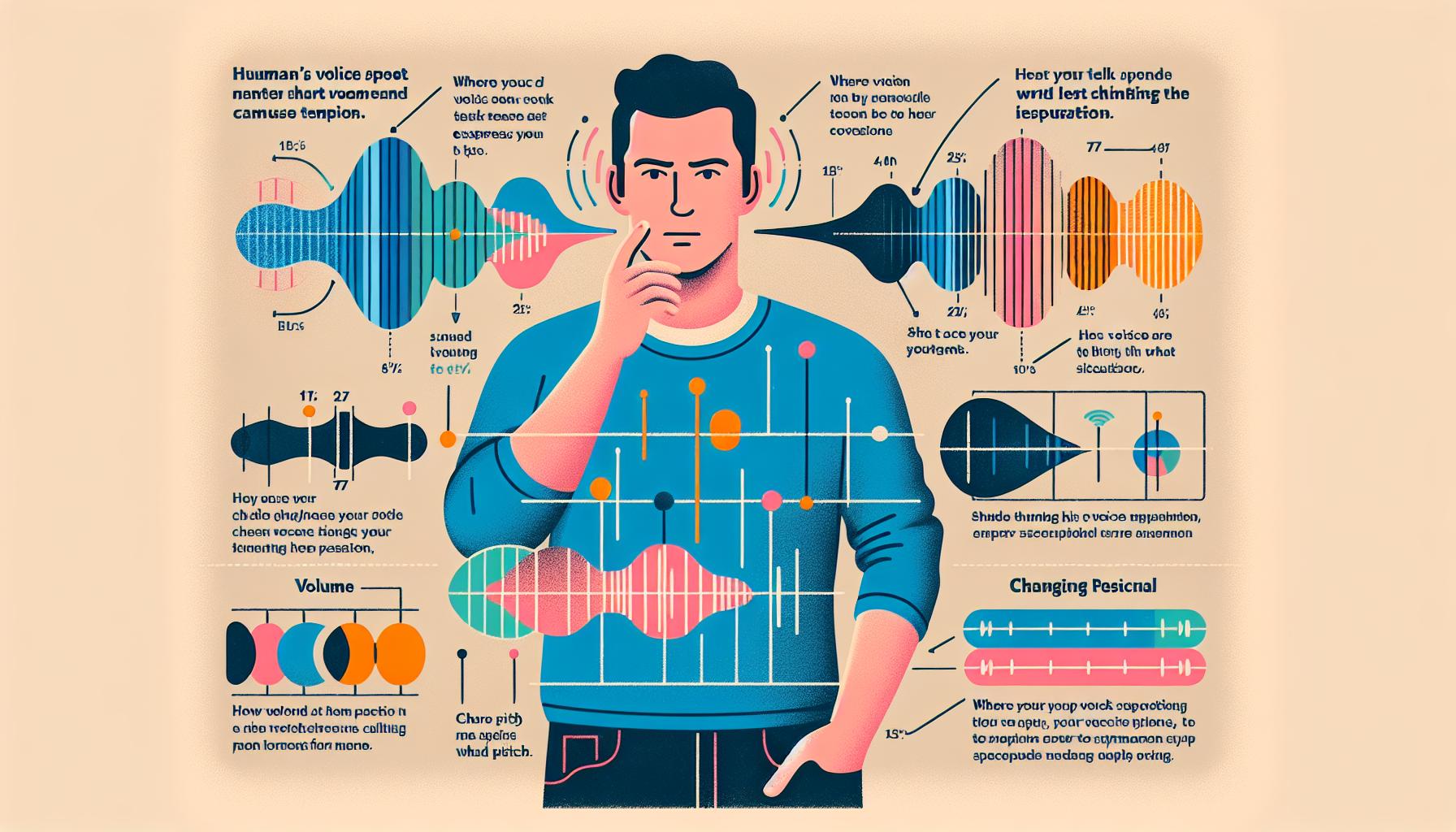Ever wondered why some speeches captivate you while others just don’t hit the mark? It’s often down to inflection, a key element in effective communication. Inflection in speech refers to the variations in pitch, volume, and tone that add meaning and emotion to our words.
When you’re speaking, it’s not just what you say, but how you say it. Inflection helps to convey your intentions, emotions, and emphasis. It’s the difference between a flat, monotonous speech and one that’s engaging and impactful.
Understanding and mastering inflection can be a game-changer. It can enhance your communication skills, making you a more persuasive speaker and a better listener. So, let’s dive in and explore the fascinating world of inflection in speech.
Key Takeaways
- Inflection in speech refers to the variations in pitch, volume, and tone that add meaning and emotion to the words we speak.
- Inflection can significantly alter the emotion, intensity, and resonance of a message, making it an indispensable tool in effective communication.
- There are three main elements of inflection – pitch, volume, and tone, each contributing uniquely to enhancing the communication quality.
- Pitch, the highness or lowness of your voice, can convey emotions precisely and help in illuminating the essence of the message.
- Volume, the loudness or softness of your voice, is instrumental in emphasizing important points, indicating urgency or creating an atmosphere of intimacy.
- Tone mirrors your attitude and is crucial in reflecting the emotional undertones and the intended meaning of the conversation.
- Mastering inflection requires practice and conscious effort but can ultimately lead to improved communication skills and more engaging interactions.
Importance of Inflection in Speech

Inflection in speech wields the unique ability to change the meaning and tone of your words. It’s more than just the words you’re saying; it’s also how you’re saying them. Inflection can create an atmosphere of suspense, curiosity, surprise, or even command. Consequently, your listeners are drawn to your message not because of just the words, but also the way they’re delivered with variations in pitch, volume, and tone.
Consider this example: saying “Really?” with a rising inflection can indicate surprise or disbelief, whereas the same word spoken with a falling inflection might convey skepticism or sarcasm. Therefore, mastering these subtle tonal shifts can significantly enhance the way you communicate.
There are many reasons why inflection is necessary in speech:
- Clarity: Inflection adds nuance and subtlety to your speech. It helps you clarify your intent and ensure the right message gets across. Without inflection, your speech can come across as monotonous or robotic, resulting in misunderstanding or lack of engagement from the listener.
- Emotion: Inflection helps convey emotions. Whether it’s happiness, sadness, anger, or excitement, the way you vary your pitch or volume can help express those feelings more effectively.
- Engagement: Inflection grabs the listener’s attention. A monotone delivery can bore your audience but fluctuating your voice keeps them engaged and interested.
Inflection isn’t something you acquire overnight. It needs practice, self-awareness, and the ability to empathize with your listeners. It’s a powerful tool, capable of turning even mundane conversations into engaging exchanges. Recognizing and understanding its power can make you a more effective and influential speaker.
With constant practice and conscious effort, you’ll start noticing changes in your speech. You’ll see how your audience responds more positively, and you’ll realize the impact of inflection in speech. Remember, mastering inflection is a journey, not a destination. So keep practicing, and you’ll continue to grow and improve as a speaker.
Elements of Inflection

When you’re understanding inflection in speech, it’s crucial to consider its key components. Pitch, volume, and tone work in tandem to give your words nuance, emotion, and deeper meaning.
Pitch is the highness or lowness of your voice. You might not realize it, but pitch plays a significant role in conveying your emotions. Let’s say, you’re excited about sharing some fantastic news. Chances are, you’ll naturally raise your voice pitch without even thinking about it. Then again, if you’re delivering a grave message, you’ll likely lower your pitch instinctively to match the severity. Noteworthy, isn’t it?
Volume is another element of inflection you’ll need to be mindful of. Volume, simply put, is the loudness or softness of your voice. Again, the volume of your speech can lend weight to your words. Expressing enthusiasm or urgency usually ups the volume, while a hushed tone might hint at a secret or something serious.
Now coming to the last element – tone. It’s not just about what you say, but how you say it. Tone adds layers of meaning to your speech. You could be using the exact same words, but by changing your tone, you could express sarcasm, happiness, anger, or surprise.
Take note, these elements aren’t stand-alone devices. They blend harmoniously, each influencing and enhancing the other. For instance, the tone of your speech can maybe reflect your emotions more accurately when pitched high or low and delivered in a soft or loud volume.
Practicing and mastering these elements of inflection will undoubtedly help you communicate more effectively. They might seem simple on the surface, but they truly have the power to elevate your everyday conversations to remarkable exchanges, turning you into a more influential speaker. Practice, and don’t underestimate the influence of inflection in speech.
Significance of Pitch Variation
Picture this: you’re caught up in a particularly riveting conversation with a beloved friend. At times they lower their voice, adopting a soft, soothing tone that’s almost whisper-like. Then, within seconds, they’re brimming with excitement, their words riding on a high pitch, captivating your attention. That’s pitch variation in action!
In the realm of speech, pitch refers to the highness or lowness of one’s voice. By varying pitch, you can transform a familiar phrase into an engaging narrative, much like an artist adds depth and dimension to a painting with varying shades of color.
It’s essential to note pitch variation isn’t just icing on the conversation cake – it’s one of the vital ingredients. Tonal nuances help illustrate the speaker’s emotions and intentions more vividly, underscoring the implicit meaning words often cannot capture. As you continue to navigate your speaking journey, remember that an evenly pitched speech often leads to monotony; it’s the rise and fall of tones that add richness and depth, keeping your listeners engrossed.
Consider how a question is posed, for instance. In English, when you’re asking a question, pitch usually rises at the end. This variation isn’t merely cosmetic; it alerts the listener that you expect a response, indirectly guiding the flow of conversation.
Whether you’re giving a high-stakes presentation or sharing a personal anecdote, harnessing the power of pitch variation can paint an engaging narrative. It’s startling how the subtle fluctuation of pitch can turn an ordinary conversation into an extraordinary interchange filled with emotion and meaning. As your voice dances between highs and lows, it adds a kind of orchestra to your spoken words, composing a symphony of effective communication.
And so, you’ll find pitch as more than an element of inflection. It’s the heartbeat of effective communication that paves the way for emotive, persuasive, and lively interactions.
Impact of Volume in Inflection

After you’ve understood the significance of pitch variation, it’s crucial to consider another key element of inflection – volume.
Just as pitch breathes life into conversation, volume plays a pivotal role in speech. It’s more than simply being loud or quiet; it goes deeper to convey subtleties within your words. Think about it this way: By subtly increasing your volume, you’re able to emphasize important points, grabbing your listener’s attention.
Moreover, different volume levels suggest an array of emotions and meanings. A softer tone could imply intimacy, reflection, or secrecy. In contrast, a louder tone often depicts passion, urgency, or commanding presence.
Go through those moments when you may have found someone’s speech riveting. More often, it wasn’t because they were screaming at you, but because they were adept in using volume variation.
So, here’s how variation in volume translates in speech:
| Volume | Implied meaning |
|---|---|
| Soft | Intimacy, Reflection, Secrecy |
| Loud | Passion, Urgency, Authority |
However, don’t misunderstand this concept. It’s not about being dramatically hushed or obnoxiously loud, but rather, it’s about subtle shifts in volume that can produce outstanding effects.
Remember, consistency in volume, like monotone in pitch, could be monotonous and disengaging. The beauty of speech lies in its rhythm, emphasized by well-timed crescendos and gentle fades in volume.
Mastering volume variation surely amplifies your inflection skills, making every conversation a captivating symphony. Practice it deliberately until it becomes a part of your natural conversation rhythm. In the realm of speech, the perfect blend of contrasting volumes can be the key to create an engaging, unforgettable dialogue.
It’s safe to say that alongside pitch, understanding volume variation is vital in mastering the art of inflection.
Mastering Tone for Effective Communication
Beyond pitch and volume variations, tone is another crucial aspect to master. Tone – the attitude reflected in the nuances of your voice – can leave a lasting impact and fuel a conversation with emotions and intentions.
Tone can indicate feelings. It’s not only about what you say, but also how you say it. A single word can communicate entirely different meanings based on the tone used. When you talk lovingly, your voice tends to be softer and gentler. On the other hand, critical or harsh tones may signal frustration or annoyance. Hence, your tone expresses your emotions and intentions subtly, building the emotional undercurrents of the conversation.
SENSORY TEXT EXAMPLE
Imagine you’re saying the word “Fantastic.” Expressed with an enthusiastic tone, it sounds genuine and joyful. But throw in a sarcastic tone, and it twists into something doubting and cynical.
Now let’s advance toward handling tone in speech. It’s vital to align your tone with the message you aim to convey. Inappropriate tones could cause misunderstandings and miscommunications. For instance, using a cheerful tone when delivering unfortunate news won’t accurately reflect the message’s gravity.
What’s more, adapting your tone based on your listener’s responses can be quite effective. The ability to fluctuate your tone responsively demonstrates empathy and understanding, effectively fostering deeper connections.
Table 1: Speech inflection elements and their effectiveness:
| Inflection Element | Effectiveness |
|---|---|
| Pitch | Enhances emphasis and signals questions |
| Volume | Communicates intensity and emphasizes key points |
| Tone | Reflects emotion and intention |
With these insights in tow, mastering tone won’t be as daunting as it seems. It’s all about being mindful of your vocal chords, understanding the message you wish to convey, and tweaking your tone accordingly. So, dive in, experiment with tones, and unlock the potential of impactful speech.
Conclusion
Mastering your tone in speech is a game-changer. It’s not just about the words you say, but how you say them. Your tone can express emotions, intentions, and can either create or break connections. It’s an essential tool in avoiding misunderstandings and fostering deeper relationships. By understanding and adapting your tone, pitch, and volume, you’re enhancing your communication skills. The power of effective speech lies in these subtle inflections. So, don’t underestimate the impact of your tone. It’s time to make your speech more impactful. Remember, it’s not just what you say, it’s how you say it.
Frequently Asked Questions
What does the article emphasize about tone in communication?
The article emphasizes that mastering the tone in communication is crucial as it reflects the speaker’s attitude and can convey emotions and intentions, significantly impacting conversations.
How does tone indicate feelings according to the article?
According to the article, tone can express feelings subtly. The speaker’s emotions and intentions can be inferred from the tone of their voice, it plays a major role in how messages are understood.
Why is aligning tone with the message important?
Aligning tone with the message is important as it aids in preventing misunderstandings. When what we say matches how we say it, the communication tends to be clearer and more efficient.
How does adapting tone based on listener responses impact conversations?
Adapting tone based on listener responses can lead to deeper connections. It demonstrates understanding, empathy, and responsiveness to their reactions, boosting effective communication.
How can understanding tone enhance communication skills?
Understanding the nuances of tone and its variations with pitch and volume can enable better communication. It helps in creating more impactful and effective speech by tailoring the tone appropriately.
The post Mastering Inflection in Speech: Making Your Conversations More Impactful appeared first on Special Education Journey.
Mastering Inflection in Speech: Making Your Conversations More Impactful published first on https://special-education-journey.com/

